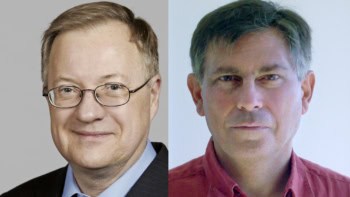Cambridge physicist Stephen Hawking and his CERN colleague Thomas Hertog have proposed a radical new approach to understanding the universe that studies it from the "top down" rather than the "bottom up" as in traditional models. The approach acknowledges that the universe did not have just one unique beginning and history but a multitude of different beginnings and histories, and that it has experienced them all. But because most of these other alternative histories disappeared very early after the Big Bang to leave behind the universe we observe today, the best way to understand the past, they say, is to trace our knowledge back from the present (Phys. Rev. D 73 123527).
Most models of the universe are bottom-up, that is, you start from the well-defined initial conditions of the Big Bang and work forward. However, Hawking and Hertog say that this method is flawed because we do not and cannot know the initial conditions present at the beginning of the universe and that we only know the final state — the one we are in now. Their idea is therefore to start with the conditions we observe today — like the universe is 3D, nearly flat and expanding at an accelerating rate — and work backwards in time to determine what the initial conditions might have looked like.
The new theory aims to get round a fundamental problem of string theory — the most popular candidate for a “theory of everything” — which is that it allows the existence of a multitude of different types of universes as well as our own. Each possible universe in this “landscape” has its own fundamental constants and even different numbers of space-time dimensions. Moreover, string theory does not favour any particular universe over another, which is not a good state of affairs as we clearly live in a universe with a particular set of physical properties.
To address this, Hawking and Hertog say that all these alternative universes of string theory may have actually existed together in the first few instants after the Big Bang. At this time, the universe was in a “superposition” of all these possible worlds. However, most of these universes then quickly faded away to leave behind our present-day universe. By tracing our universe back from the present to the past, we can ignore most of other branches that the universe took because they are too different from the current universe.
While this idea sounds fantastic, it is based on Richard Feynman’s “sum over paths” formulation in quantum theory, which says that the probability that a photon, say, arrives at a particular place can be calculated by summing up over all the different possible trajectories of the photon. Although the photon could follow lots of different paths, the straight-line path dominates over all the others so this is the one we see. In the same way, Hawking and Hertog say that the universe did not take just one path through time to arrive in its present state, but took a multitude of paths, or histories. The “sum over all histories” is therefore the universe we observe today.
The new top-down theory could also explain why some constants of nature seem to have finely tuned values that have allowed life to evolve in our universe. For example, the cosmological constant, Λ — the force that appears to be causing the expansion of the universe to accelerate, or the density of dark energy — has a small positive value; if it were any smaller or bigger then life would not exist. According to the new theory, the current universe must have “chosen” those histories that led to the “correct” value of Λ otherwise we would simply not be here to experience it — a theory also known as the “anthropic principle”.
Hawking and Hertog also say their model could be tested by comparing observations of the patterns of minute intensity variations in the cosmic microwave background (CMB) radiation with those calculated by their theory when it is more developed. The CMB is the radiation left over from the Big Bang and should contain “imprints” of some of the very early alternative histories within it.



